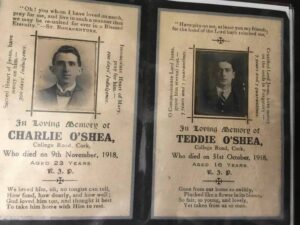Many of the stories gathered for Catching Stories have been about overcoming obstacles put down by the various infectious disease. People showed incredible resilience after being put through horrifying circumstances. Many of whom prevailed to have a good life. Sadly, this is not true of every story. For many, the ultimate price of contracting devastating infectious diseases was death. In this section, we hear how the death and loss of family and friends affected the ones they left behind.
 The loss of Teddie and Charlie O’Shea of College Road
The loss of Teddie and Charlie O’Shea of College Road
Objects can survive down through the generations in family homes that open up a window on the experiences of other families. When cleaning out the family home in Cork City, Jim Morrish came across a large number of memorial cards that had been kept by previous generations, tucked away in books, bibles, hymn books, purses and drawers. He shared one of these cards on a Cork City Facebook
group in February 2021, wondering if the young men pictured had died of Spanish Flu.
The memorial card, pictured here courtesy of Jim, was a double card picturing two brothers, Teddie and Charlie O’Shea, from College Road, Cork. Teddie had died on 31 October, 1918, aged 16, and Charlie less than two weeks later, on 9 November, 1918, aged 24. A search of the death registry shows the deaths of Timothy Thomas and Patrick Charles O’Shea, both listed as ‘Child of Police Pensioner’. The ‘Certified Cause of Death and Duration of Illness’ for Teddie was ‘Double Pneumonia 10 Days Certified’, and for Charlie it was ‘Double Pneumonia 2 Days Certified’.1
On the day of Jim’s Facebook post, the two men’s nephew Pat O’Shea and grandniece Sasha O’Shea commented on the thread. They were able to fill the group in on the background. ‘We were told they survived the war but the Spanish flu killed them. It was a very sad time in the home on College road.’
Charlie and Teddie O’Shea’s parents had been very friendly with Jim’s grandmother and grandfather, and that is how the card had come into his family.
Thanks to Pat and Sasha O’Shea and Jim Morrish.
[1] Although in Charlie’s ‘Form to be used for making out Occasional Copies of Entries of Deaths for transmission to the Registrar-General’, 2 days is crossed out and the figure 6 is inserted.

Three deaths in a year
Johnny ‘Chris’ Kelleher’s account of how he came into a career in newspaper selling starts with a tale of devastating familial loss.
Johnny was born in 1929 in Fair Lane, later called Wolfe Tone Street. His mother, Mary Margaret Kelleher (1901 – 1970) was married twice; her first husband died of tuberculosis in 1924. In this excerpt, Johnny tells of his mother being widowed and having further tragedy fall upon her family. Where she lost two of her sons, one to diphtheria and one to croup.
This interview was conducted by Michael Daly
‘Kitty O’Brien … and a little bow on top of her head’
Sister Marie Collins was born around 1920 in Limerick, to farming parents, and became a Presentation Sister and a teacher. She attended primary school in Monaleen, near where the University of Limerick is currently situated. Sister Collins was interviewed in 2000 by the Cork Folklore Project, and during the interview she reflects on the way in which certain memories from her early childhood stand out in isolation. Speaking of a scene that comes to her memory with clarity, as an isolated incident, she says: ‘Now, I remember that, and I have no memory before or after but that stands out in my mind. Do you know, extraordinary things. I remember the first day I went to school, being around the teacher’s table, but I have no recollection of the night before or days afterwards… I’d love to write down memories without anything before or after, just things that struck me there and then.’
She goes on to recount one such vivid memory, of a girl who had been in Low Babies (Junior Infants, the first primary school class that children attend) with her.
Transcription of part of this extract (the item entry can be accessed here):
‘And we must have been in Low Babies, we had a high stool and a low stool and there were the High Infants and The Low Infants. and the two of us got the measles. And I can still see this little one, Kitty O’Brien, she had straight hair and a fringe, and a little bow on top of her head. And when I went back after the measles she was dead, she had died from the measles. I can still see her little wee face. And I got measles, and I didn’t die, but she died. So, you know, things like that. You’d say: ‘I can’t remember a bit of before or after but I remember that.”’
